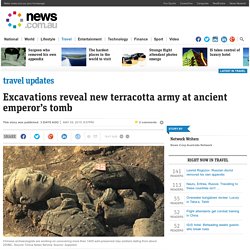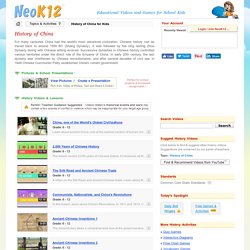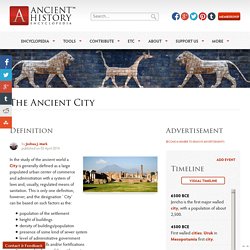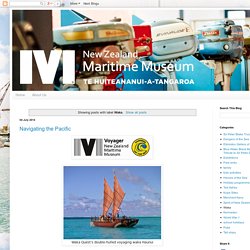

Matsés. China begins to excavate new terracotta army figures. Surgeon who removed his own appendix FORGET 127 Hours, this extraordinary Russian doctor performed an operation on himself when he contracted appendicitis on a remote Antarctic base.

WARNING: GRAPHIC CONTENT IS takes control of luxury hotel THE Islamic State continues to expand its influence, and has commandeered a five-star hotel as a bizarre venue for jihadi weddings. Plane came this close to collision THIS takes the phrase “close call” to a whole new level. Britain's 250,000 boy soldiers in World War I. History of China for Kids - History Games and Videos. History of China for Kids For many centuries China had the world's most advanced civilization.

Chinese history can be traced back to around 1550 BC (Shang Dynasty). It was followed by the long lasting Zhou Dynasty during with Chinese writing evolved. Successive dynasties in Chinese history controlled various territories under the direct rule of the Emperor of China. In early 20th century, the last dynasty was overthrown by Chinese revolutionaries, and after several decades of civil war, in 1949 Chinese Communist Party established China's current government.
Pictures & School Presentations : History Videos & Lessons: Search Videos Suggest History Videos Click below to find & suggest other history videos. Engineering an Empire: China, Part 3. Journals Through History Ancient China Contributions to the World. New Discoveries in Chinese Archaeology.
Ancient Civilizations. Stone age man. The Ancient City - Ancient History Encyclopedia. In the study of the ancient world a City is generally defined as a large populated urban center of commerce and administration with a system of laws and, usually, regulated means of sanitation.

This is only one definition, however, and the designation `City' can be based on such factors as the: Indus Valley Civilization. The major sites of the Indus Valley Civilization imposed over modern borders The Indus Valley Civilization (IVC) was a Bronze Age civilization (3300–1300 BCE; mature period 2600–1900 BCE) extending from what today is northeast Afghanistan to Pakistan and northwest India (see map).

Along with Ancient Egypt and Mesopotamia, it was one of three early civilizations of the Old World, and the most widespread among them, covering an area of 1.25 million km2.[3] It flourished in the basins of the Indus River, one of the major rivers of Asia, and the now dried up Sarasvati River,[4][5] which once coursed through northwest India and eastern Pakistan together with its tributaries flowed along a channel, presently identified as that of the Ghaggar-Hakra River on the basis of various scientific studies.[7][8][9] The Harappan language is not directly attested and its affiliation is uncertain since the Indus script is still undeciphered. Discovery and history of excavation Chronology Geography Cities. WebQuest. What The Ancients Did For Us The Indians. New Zealand Maritime Museum: Waka. According to the Tahitian story, the ancient king and voyager Tumu-nui listed eight dangers of the sea: long-wave, short-wave, isolated-coral-rock, fish-shoal, sea-monster, animal-with-burning-flesh, crane-empowered-by-Ta'aroa [the supreme god of creation], and giant-clam-opening-at-the-horizon.

Tumu-nui’s nephew Rata succeeded in destroying six of these dangers so that only two remained – long wave and short wave. How the Ancient Romans Made Better Concrete Than We Do Now. Kinja is in read-only mode.

We are working to restore service. Concretes problem isn't the atmosphere (well not 100%, I'd say something like ~10% ish for the things you are talking about), it's the fact we use 1000s of 18-wheelers of 5+ tons each that damage the roads. Romans never had that sort of weight bearing down on their concrete, and the amounts of concrete we do see are the buildings, which, yes, us civil engineers do admire their ability to make an efficient enough concrete to have lasted this without needing reinforcing steel in it. What did the Romans ever do for us? They left a water warning. As all good Monty Python fans know, water technologies feature large in the legacy of benefits left by Roman civilisation.

But while aqueducts, sewers and baths retain an obvious presence in the landscape and in the archaeological record, the Romans' largest and most important water achievement may have been “virtual”. The Romans developed networks of trade and food supply that enabled them to escape local water constraints, in a way that is explained in a new study in the journal Hydrology and Earth System Sciences. Fertile regions such as southern Spain or Italy’s Po valley would grow lots of food and ship it back to Rome or to the drier outposts of the Empire. Embedded within this is a what geographers call a virtual water trade – an indirect way of shifting this precious resource from wetter, less populated areas to those regions with more people or a less consistent climate. The map below shows this in action. All ships lead to Rome.
Mummy Magic.